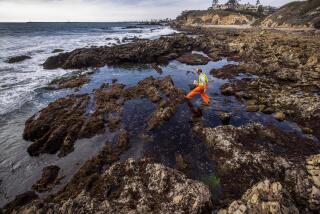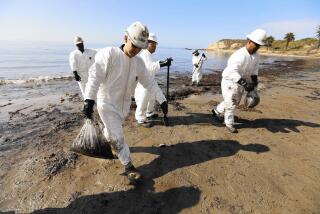Remaining Oil Pumped From Stricken Tanker : Million-Barrel Transfer Clears Way for Attempt to Refloat the Vessel
VALDEZ, Alaska — Exxon on Tuesday finished pumping out the last of the nearly 1 million barrels of recoverable oil from the stricken tanker Exxon Valdez, clearing the way for a salvage crew to try to refloat the 987-foot vessel at high tide today.
Completion of the most ambitious remote oil-transfer effort of its kind ever attempted--an effort that prevented the worst oil spill in the nation’s history from being four times as bad--is the first tangible progress made by the oil company in managing the disaster.
News of the successful oil transfer came as local fishermen reacted with bitterness and dread to the mounting damage inflicted on lucrative local fisheries by the 240,000-barrel spill. Closure on Monday of herring fisheries worth an estimated $12 million will particularly hurt boats that rely on that early catch to prepare for the salmon season later in the month.
“It is very devastating and very tragic,” said Michelle Hahn O’Leary, spokeswoman for a fishermen’s union in Cordova, a nearby fishing town. “It has left the town feeling violated.”
Salmon Hatchery Hit
The battle is not over. The full brunt of the massive oil slick is just beginning to hit hard at Sawmill Bay, site of a large salmon hatchery in the southwest corner of Prince William Sound.
Three absorbent booms have been stretched across the mouth of the bay and nine surface-skimming boats are attacking incoming oil, but the hatchery’s fate, and that of the millions of fish it can produce, remains in doubt.
Frank Iarossi, president of Exxon Shipping Co., said Tuesday that a thin sheen was seen curling beyond the first boom. Water from various points and depths in the bay is tested regularly around the clock to see if hydrocarbons are sneaking in under the protective surface baffles.
None has been detected so far, he said, but little pollution is needed to kill the estimated 172 million juvenile fish at the hatchery. He said a fourth, larger boom--42 inches in diameter--has been ordered from Anchorage and plans have been made to airlift the fry to other hatcheries if necessary.
“We’re scared to death about the thing,” he said.
Of about three dozen oil-soaked otters rescued following the spill, about one-third have died, Alaska Department of Fish and Game spokesman Jon Lyman said. “Dozens of otters are dying before rescuers can get to them,” he said. Six otters were flown to Sea World in San Diego on Monday for rehabilitation.
Despite promises to clean up the environment and make good any financial losses, Exxon has been severely criticized by state officials and local residents for reacting too late with too little in the 12 days since an unqualified crew member steered the tanker onto a well-designated reef in the wildlife-rich sound.
Could Have Been Worse
Bad as that spill is--and it has spread a slick over 1,000 square miles, fouled more than 800 miles of beaches and threatens to dislocate local fisheries for years--it could have been much worse had the crippled and rent Exxon Valdez disgorged its entire 1.2-million barrel load.
With that threat squelched--Iarossi said 984,000 barrels of 42 gallons each were pumped into three smaller tankers over the past 10 days--the stricken vessel can be moved well away from shipping lanes, possibly allowing the port to resume normal operation and relieve tight oil supplies on the West Coast.
Efforts to refloat the Exxon Valdez are scheduled for early afternoon, when compressed air will be forced into its sealed hold. Naval architects hired by Exxon believe that this, along with the high tide expected at the time, will lift the 3-year-old tanker about three feet off Bligh Reef.
That well-known rock formation 52 feet below the surface is what tore the bottom out of the tanker, which when fully loaded rides about 54 to 56 feet deep.
“We clearly are going to do this slowly and carefully,” Iarossi said. “Our folks are told that if we miss this first (high) tide, they can try others over the next two days. We are not going to rush this to meet some schedule.”
Once afloat, the tanker is scheduled to be towed by six tug boats to Outside Cove on Naked Island, about 25 miles to the southwest. There, temporary repairs will be made before the tanker limps to a dry dock large enough to accommodate it.
Portland, Ore., was Exxon’s initial destination for the extensive permanent repairs required by its $125-million ship, but Oregon Gov. Neil E. Goldschmidt threatened to try to prevent repairs in his state unless he is convinced the tanker will not foul the Columbia River on its way to Portland.
“There are a lot of questions that need to be answered before the Valdez enters the mouth of the Columbia,” he said in Portland. “The burden of proof to show that safe passage is possible will be on Exxon. And ‘trust me’ is not good enough. The performance standards against which (Exxon) will be measured will be very high.”
It is not clear if Goldschmidt has the authority to prevent Exxon’s tanker from entering the Columbia River, which as a navigable waterway is governed by the federal government. But Exxon, not eager to anger another governor, said Friday that if necessary it will take the stricken vessel to Japan, Korea or Singapore for repairs.
The repair job has been estimated at $12 million, and may employ as many as 200 workers.
Oil-Skimming Boats Helpful
Meanwhile, Iarossi said special oil-skimming boats have proven to be especially effective at picking up the gooey, emulsified crude oil still in Prince William Sound in large quantities. Five of the vessels already have arrived, and Iarossi said the company is trying to bring in 13 more from the East Coast, two from France, and another from Great Britain.
Giant C-5A military transports are ready to fly the boats to Alaska if the company can persuade their owners to lend them.
“There’s some sensitivity to moving all this equipment here,” he said, “because people believe it could leave them exposed.”
The Bush Administration said Tuesday it would oppose any move to close the Alaska pipeline but acknowledged it was unclear whether the federal government has legal authority to prevent it.
White House Press Secretary Marlin Fitzwater said the authority issue was “an open question.” However, he said, “I don’t honestly believe anybody wants to close the pipeline.”
Alaska Gov. Steve Cowper has threatened to shut the pipeline unless Exxon and other oil companies produce a better plan to deal with big oil spills. Democratic and Republican state legislators have backed up Cowper.
Fitzwater said: “We’ve seen those comments (by Cowper) but we simply don’t think it would be in the national interest to close the pipeline.”
William K. Reilly, Environmental Protection Agency Administrator, told Congress that the massive Alaskan oil spill could put the brakes on petroleum exploration there and in other areas--at least temporarily.
“We will take apart the environmental planning for every aspect of oil development in Alaska and in other sensitive areas where the environment potentially could be threatened,” Reilly told a House appropriations subcommittee.
Staff writer Larry B. Stammer in Portland, Ore., contributed to this story.
More to Read
Sign up for Essential California
The most important California stories and recommendations in your inbox every morning.
You may occasionally receive promotional content from the Los Angeles Times.










